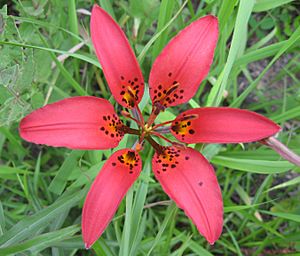Wood lily facts for kids
Quick facts for kids Wood lily |
|
|---|---|
 |
|
| Scientific classification | |
| Kingdom: | |
| (unranked): | |
| (unranked): | |
| Order: | |
| Family: | |
| Genus: | |
| Species: |
L. philadelphicum
|
| Binomial name | |
| Lilium philadelphicum |
|
| Synonyms | |
|
|
The Lilium philadelphicum, often called the wood lily or Philadelphia lily, is a beautiful wild flower. It is a type of lily that grows year after year. You can find it naturally in North America.
Contents
Where Wood Lilies Grow
This plant is found in many parts of Canada, from British Columbia all the way to Quebec. It also grows in parts of the United States, especially in the Northeast, the Great Lakes area, and in the Rocky and Appalachian Mountains.
What Wood Lilies Look Like
Wood lilies usually grow to be about 30 to 90 centimeters tall. That's about one to three feet high. They have bright red or orange flowers that bloom during the summer, usually from June to August.
Types of Wood Lilies
- Lilium philadelphicum var. andinum is a type of wood lily found in the central and western parts of the United States. This specific variety is very special to the Canadian province of Saskatchewan. It is their official floral emblem and is even shown on the flag of Saskatchewan.
Protecting Wood Lilies
Because they are so special, wood lilies are protected in many places. In some U.S. states like Maryland, New Mexico, Tennessee, and North Carolina, they are listed as an endangered species. This means there are very few left, and they are at risk of disappearing. In Kentucky and Ohio, they are considered a threatened species.
In Saskatchewan, Canada, where it's the provincial flower, it's against the law to pick, dig up, or harm a wood lily. This helps make sure these beautiful flowers can keep growing for everyone to enjoy.
Wood Lilies and Pets
It's important to know that lilies, including the wood lily, can be very dangerous for cats. If a cat eats any part of a lily, it can get very sick, and it can even be deadly.
If you have cats, it's best not to have these plants in your home or garden. Even pollen from dried flowers can be harmful if a cat gets it on their fur and then licks it off. If you think your cat has eaten part of a lily, you should get help from a vet right away.
Traditional Uses of Wood Lilies
Long ago, some Native American groups used to eat the bulbs of the wood lily.
Gallery
-
Rare yellow form in Logan County, North Dakota, USA
-
Exhibit at Callaway Gardens
See also
 In Spanish: Lilium philadelphicum para niños
In Spanish: Lilium philadelphicum para niños






